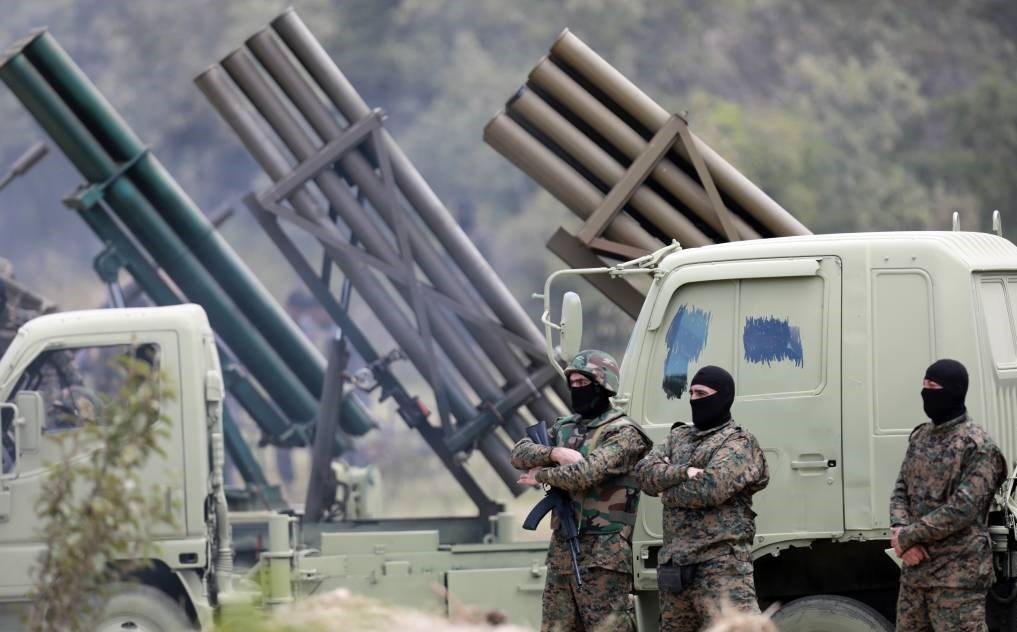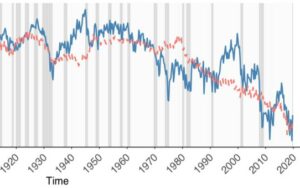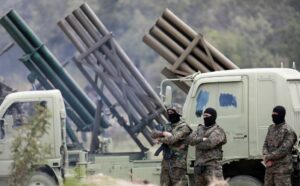On July 14th, 2006, two days into Israel’s bombing campaign against Lebanon, Hezbollah announced a special televised address from Secretary General Hassan Nasrallah.
During his speech, he promised the Lebanese people a cathartic surprise. “Now, in the middle of the sea, facing Beirut, the Israeli warship that has attacked the infrastructure, people’s homes, and civilians” he teed up, “look at it burning.” Viewers followed his instruction and looked onto the Mediterranean sea with disbelief when, right on Nasrallah’s cue, the Israeli naval vessel parked off their coast was suddenly engulfed by a bright orange fireball. Hezbollah’s anti-ship missiles, which Israelis were unsure they possessed until this strike, successfully penetrated the American-built Israeli warship, the INS Hanit, killing multiple sailors and decommissioning it for the rest of the war’s duration.
This was just one of 33 days of embarrassments the Israelis endured during their last confrontation with the Shia nationalists in South Lebanon.
Expecting a hit-and-run insurgency, poorly trained IDF soldiers were astonished to find fortified fighting positions and a professional army capable of holding ground and defeating them in set-piece battles. IDF Commander Dan Halutz, who was later forced to resign as the scapegoat for Israel’s abysmal performance in the conflict, had focused his battle doctrine entirely on Iraq war style “shock and awe” aerial bombing, except in his case, in lieu of any coherent plan for a follow-up ground invasion. This strategy was a failure from the start. Hezbollah had prepared to counter Israeli air supremacy by orienting their logistics around a network of underground bunkers and tunnels. When all was said and done, just 7% of Hezbollah’s military resources were damaged by the Israeli Air Force.
In addition to miniaturizing the Israeli artillery and air power advantage, Hezbollah possessed a multitude of effective counters to Israel’s sophisticated surveillance tools, drones, Merkava tanks, and diplomatic scams.
Upon driving Israeli forces out of South Lebanon in 2000, effectively ending an 18 year occupation, Nasrallah wisely ignored American and UN promises to ensure respect for Lebanese territory and began immediately preparing for the Zionists to return with a vengeance.
Hezbollah’s foresight paid off in dividends six years later, when the first Israeli Merkava tank used to cross into Lebanese territory in violation of the UN’s imaginary “blue line” was blown to pieces along with its crew by a perfectly laid anti-tank mine. Up to this moment, Merkava tanks were advertised to the Israeli public as practically indestructible. Another surprise weapon, Russian made Kornet ATGMs, helped destroy countless more tanks and vehicles.
Looking back on the conflict, pop historians and mainstream journalists have refused to grant Hezbollah victory and instead settled on referring to the outcome of the 2006 war as a stalemate. But this view is not held by experts with skin in the game, such as Matt M. Matthews of the US Army Combined Arms Center at Fort Leavenworth, who has written about Israel’s performance in the war as a textbook example of what a catastrophic military failure looks like. The Israeli government’s own 2007 Winograd Commission excoriated every facet of the campaign, from the top generals to the average soldiers to the IDF’s core doctrine, prompting Nasrallah to react with praise for the candidness of the Israeli investigators.
The key to understanding Hezbollah’s approach to Israel is in Nasrallah’s view that Jews are weak and opportunistic bullies. Nasrallah holds that the Israeli public is a fragile “spider web,” one which constantly cries out for Arab blood but simultaneously has a low threshold for pain and inconvenience. By inflicting heavy military casualties and forcing Israelis in towns and cities either into bunkers or to flee their homes, Hezbollah believes the Zionist state can collapse under its internal contradictions.
Following the October 7th attacks by Hamas, these contradictions have come to the surface. Two of the most hawkish figures on Lebanon in Benjamin Netanyahu’s cabinet, Itamar Ben-Gvir and Bazalel Smotrich, were put into power by a Haredi voting bloc that, while loudly demanding war, has tirelessly fought the Israeli state since its inception in 1948 to be exempt from military service. Analysts, many of them Jews, fear that this lack of civic virtue among the Haredim is demoralizing the secular majority of Israel, who could respond to the hypocrisy by taking their sons out of the country to dodge the draft if the war expands.
Hezbollah has also succeeded in turning Israeli territory, which lacks strategic depth, into the frontline of the ongoing skirmishes, forcing 60,000 Jewish citizens to flee their settlements to the center of the country. This has angered the Israeli hoi polloi, causing the internally displaced to issue infantile demands to Netanyahu that he needs to quickly crush Hezbollah so that their children can start school on time in September.
The typical Israeli’s ambitions are completely out of sync with their actual will power and abilities. This petulant and craven citizenry’s inability to connect actions to reactions is so stunning that it has prompted IDF army chief Herzl Halevi to issue a statement telling the public that they do not seem to understand the magnitude of the consequences that await them once the war in Lebanon formally begins.
That is not to say they are completely out of touch with reality. Israelis have a secret weapon too: the unopposed Zionist control of Western capitals.
The US and France, two of the parties responsible for intercepting Iran’s April counter-strike on Israel, have dispatched emissaries to Lebanon under the guise of trying to negotiate an end to hostilities between Israel and Hezbollah.
Hezbollah’s sole demand is that Israel permanently end its brutal war on the Palestinian people, but this has become a non-starter largely due to the absurd dynamic in the talks.
America’s envoy in the effort, Amos Hochstein, is an Israeli businessman and well-established Zionist ideologue serving in the Biden administration. France’s representative, Foreign Minister Stéphane Séjourné, is the gay boyfriend of Jewish Prime Minister Gabriel Attal — an unprecedented, obscene and comical display of nepotism. These “referees” have a dog in the fight, and for this reason, diplomacy has gone nowhere.
The latest reports from Hochstein point to the United States getting ready to follow Israel into south Lebanon, a mission the two Zionist powers trained for during last year’s Juniper Oak exercises. The US congress’ move to quietly modernize America’s military conscription system gives us a glimpse into the types of conversations happening behind closed doors. What could complicate matters is that all of Israel’s likely co-belligerents — USA, UK and France — will soon be having national elections, which is unlikely to significantly effect the big-picture calculus, but could raise at least some unknown variables.
A factor working against Hezbollah is that the amount of pain such a war will cause the Lebanese people is unimaginable. Netanyahu has publicly stated that the IDF’s plan is to turn Beirut, a city of 2.4 million, into Gaza. During the 2006 war, Israeli forces frustrated by their inability to advance more than a few miles into Lebanese territory eventually gave up on fighting Hezbollah and leaned into the Dahiya Doctrine, which deliberately targets civilians in hopes of breaking the spirits of defenders and generating internal political pressure against Hezbollah. Many believe that in the next war, Israel and its Western sponsors will be taking the Dahiya Doctrine to new heights in hopes of compelling the Lebanese army, Christian militias and even some Sunni purist groups to attack the Shia fighters from behind and fight another civil war inside the multi-confessional state.
Assuming the most ideal circumstances, the war will also be difficult for the Zionist powers. Hezbollah’s highly sophisticated and vast armory and manpower (believed to be 100,000 fighters), arguably could make it the strongest army Israel has ever fought. Intelligence agencies now believe that Hezbollah possesses formidable Russian-made anti-ship missiles that present an acute threat to America’s Navy.
Hezbollah’s army is also hardened and experienced in offensive tactics and urban warfare due to its participation in anti-ISIS campaigns in Syria. The potential for the next war spilling well into Israeli territory is high. Drone footage published by Hezbollah this week revealed that they have the ability to collect surveillance footage deep into Israeli air space, and their massive stockpile of precision-guided missiles and rockets are capable of reaching these targets.
An earlier video showing Hezbollah destroying an Iron Dome missile defense battery, one of only 10 in Israel’s possession, was publicly ignored by the IDF, but behind the scenes they are scrambling to allocate money for emergency research into figuring out ways to better protect these weapons.
The built-in economic disadvantage of Iron Dome is another potential problem. Hezbollah possesses a bottomless well of $300 dollar Katyusha rockets to bog down Israeli interception technology, while each shot of Iron Dome’s Tamir missiles costs $100,000 dollars.
Iron Dome’s effectiveness against Hezbollah’s weapons is also debatable. A key instrument of long-range Israeli surveillance, the Sky Dew, was blown away after a Hezbollah drone circumvented Iron Dome.
With a full-scale American intervention supporting Israel, Hezbollah would theoretically struggle to stay in the fight without high quality anti-aircraft technology, but their capabilities on this front remain an open-ended mystery.
Nasrallah appears to be fully cognizant of the American threat, as is Washington. When the war in Gaza began, the USS Eisenhower was immediately dispatched to the Mediterranean in order to deter Hezbollah from entering the fray, which had the temporary effect of reducing Lebanese harassment of Israeli forces.
But Hezbollah has its own allies, the Axis of Resistance. The decision by the Houthis of Yemen to fire upon any ship owned by Israel or supplying Israel forced the USS Eisenhower to be rerouted to the Red Sea, where it has utterly failed in its mission. Forces in Northern Yemen have managed to bog American warships down under perpetual drone and ballistic missile barrages, caused the deaths of Navy SEALs, and have successfully sunk two cargo ships this month.
The overworked crew on the USS Eisenhower is expressing fatigue and demoralization due to their long deployment, triggering internal disputes in the Pentagon between the Navy, which wants to bring them home, and US Central Command, which is demanding to keep them in theater indefinitely. There is a mounting fear that Iran and possibly even Russia (as a response to Washington authorizing Ukrainian strikes in their territory) could be weighing supplying the Houthis with better weapons that could sink American aircraft carriers.
Baiting the US into this wild goose chase in the Red Sea has allowed Hezbollah to operate with greater leeway in Northern Israel, which brings us to the next variable: how deeply are Hamas, Hezbollah, the Houthis and Iran cooperating?
One theory developed by Israeli intelligence is that Hezbollah is currently upping the ante as a screen to buy time and distract the Zionist alliance while Iran rushes to develop nuclear weapons.
Recent intelligence reports suggest that Iran is months away from building six to eight nuclear bombs. This is no longer in the realm of fantasy, such as the 2012 episode where Netanyahu held up a picture of a cartoon bomb, it is now the ruling of the International Atomic Energy Agency (IAEA). America, France, Britain and Germany have responded to these developments by slapping even more sanctions on Iran, but the response has only galvanized the Islamic Republic and caused them to surge resources to their nuclear program.
The situation is spiraling quickly. Rafael Grossi, head of the IAEA, has resorted to going to Moscow and begging the Russians to stop Iran. Mirroring Antony Blinken’s desperate appeal to China to help Israel against the Houthis, the Russians have ignored the request from these hostile actors.
A recent survey has found that 69% of Iranians believe the country should develop nuclear weapons as a means to self-defense, the first time in history a majority has held this view in the country. With few exceptions, candidates seeking to replace deceased president Ebrahim Raisi, ranging from hardliners to moderates, are expressing support for pursuing nuclear weapons in debates and media comments. One prospect growing in popularity, former Revolutionary Guard Corps commander Vahid Haghanian, is perceived to be even more determined to drive the US and Israel out of the Near East than his predecessor.
In May, an Iranian parliament member hinted that they already have a nuclear weapon. These new developments could be aimed at adding to their armory in order to achieve a semblance of parity with Israel’s estimated 90 nukes.
If the Mossad is right about the trouble brewing on their border, the current tensions over Lebanon will soon be forgotten as a mere feint. Can the view held by Israel, America, France, Germany and Britain that 7.2 million Jews are entitled to exercise permanent military dominance over the other 486 million people of the Middle East survive a nuclear-armed, China and Russia backed Iran? We will see.
This article originally appeared on Littoria and has been republished by The Noticer with permission.





















